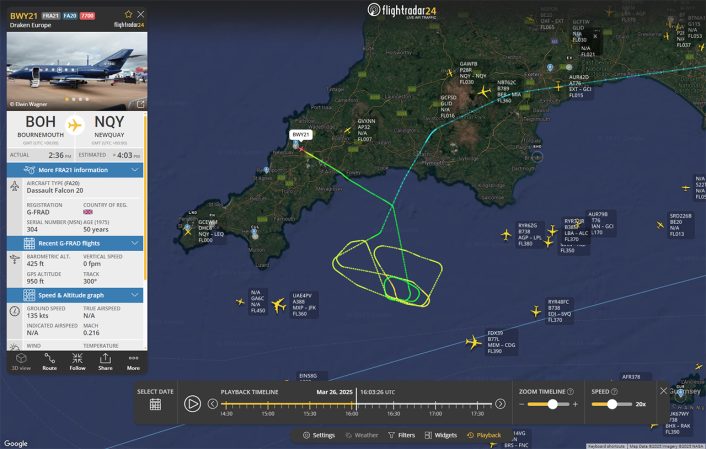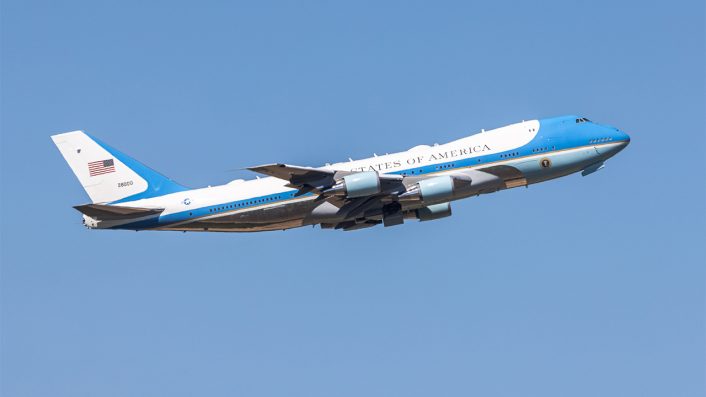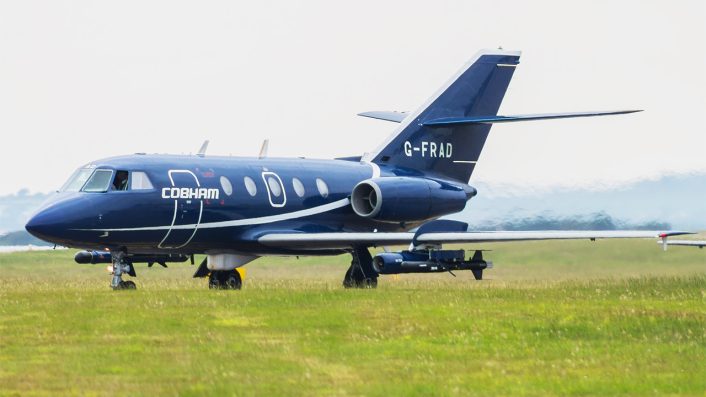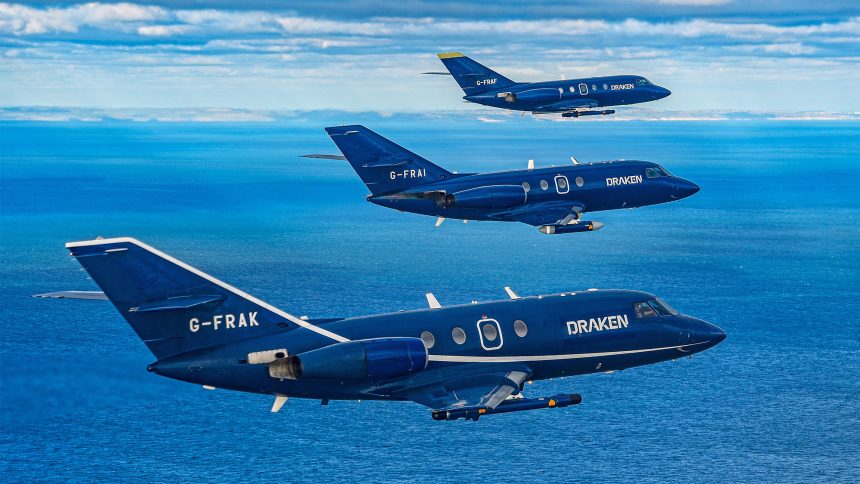A Falcon 20 declared an emergency with a stuck target winch cable, which later detached and fell onto a house during landing.
The Falcon, registration G-FRAD, was flying under the callsign BROADWAY 21 in the regularly used military training areas off the southwestern UK coast on Mar. 26, 2025. At some stage during the flight, which involved the use of a towed target, the winch cable that allows the target to be deployed and retracted in flight malfunctioned and became stuck in a deployed state.

Procedures for this eventuality exist, which usually involve an attempt to trigger a mechanism to cut the cable and dump the entire assembly over the sea or empty land. Unfortunately, on this occasion, these procedures failed to rectify the problem and the crew were forced to seek an emergency landing at the nearby Cornwall Airport Newquay with the target still in tow.
While on the approach path to Newquay’s runway 30, just after 1600 UTC, the cable and target finally did dislodge and fall from the aircraft without input from the crew. A large part of the target itself fell into a tree, while other parts landed directly on a house below in a small rural settlement named Tregaswith. Smashing through the house’s slate roof and into the property’s bathroom, the debris caused major damage to the walls, tiling, and the toilet.
A house near Newquay was hit by debris from plane pic.twitter.com/dpmYC6cbZr
— BBC Cornwall (@BBCCornwall) March 27, 2025
Property owner Sue Rundle contacted a neighbor and her son to investigate what had caused the damage, discovering a very heavy piece of what they had identified as lead amongst the rubble. Devon & Cornwall Police were contacted and attended the scene shortly after 1700 UTC along with fire service personnel.
News of the incident broke in local press the following morning (Mar. 27) with a confirmation from the police that no injuries had been reported. The UK Air Accident Investigation Branch (AAIB) also confirmed that they have opened an investigation.
Chief Executive Officer of Draken International Nic Anderson confirmed that the incident had involved a towed target from one of the company’s aircraft, and said Draken was “incredibly sorry for this very serious accident”.
Speaking to BBC Radio Cornwall, Anderson explained:
“As we were releasing the cable out from the winch under the wing, the mechanism to control the release malfunctioned, which meant we could neither wind that back in or release it and discharge it into the sea. In that case, the crew followed the procedures and declared an emergency to seek the nearest airport to divert to. It appears that on the approach to Newquay, the cable and the target were released. That is the debris that really unfortunately fell on the farm and a couple of properties.”
Alongside the damage to the house, the cable used to tow the target was found strewn across a nearby field. Draken have confirmed that all target towing from their aircraft will be suspended until the systems used can be guaranteed as safe.
Rundle says she feels very fortunate, believing it was a freak accident. Living in Tregaswith, less than a mile from the airport, low flying aircraft are a daily occurrence. She questions why the cable had not been cut off, or the aircraft diverted over water, but as we know from subsequent statements from Draken an attempt had already been made to ditch the faulty equipment.

Target Towing
Target towing is one of many capabilities offered by Draken’s Falcon 20 fleet, which are based at Bournemouth Airport and Teesside Airport. Under contract to the UK Ministry of Defence, the aircraft fly almost daily missions providing Red Air services against Royal Air Force, Royal Navy, and allied units. They can be equipped with a variety of electronic warfare pods, and it is, reportedly, not uncommon to hear them jamming communications frequencies by blasting loud music over them.
Other pods can be used to interface with the software of opposing aircraft, allowing the Falcons to mimic the radar and emissions signatures of adversarial aircraft like the Su-34 ‘Fullback’ and their weapons. Before their retirement in 2022, Hawk T1s of 736 Naval Air Squadron would work closely with the Draken Falcons. In their signature move, used against ships during training exercises, would see Hawks form on the wing of the Falcon before ‘launching’ themselves to simulate a sea-skimming anti-ship missile attack.
View from back seat of a Hawk jet of 736 Naval Air Squadron making simulated attack on @hms_albion and escorting frigate during air defence exercise
via @RNASCuldrose pic.twitter.com/6NuYK1GDs2
— Navy Lookout (@NavyLookout) October 25, 2019
The Falcons were previously operated by Cobham Plc until that company’s acquisition by Draken International in 2020. Though not young aircraft (G-FRAD itself is approximately 50 years old), they have been well maintained and no replacement is known to be pending.
For target towing, the Falcons employ a Parker Meggitt RM-30 winch. This winch can accommodate a towline up to 31,000 feet in length and is an industry standard for military training in countries across the world. The target fitted to the end of the reel is down to the needs of the end customer. In Draken’s case, one such option is the ‘Black Kite’, seen in the image below mounted on a hardpoint to the right of the winch system.

The Black Kite can be configured to fly at different altitudes, with the ability to replicate a sea-skimming missile down to a height of 25 feet above sea level.
Interestingly, target towing is far from a new introduction to Cornish skies. As far back as the early Second World War, entire bases have been dedicated to the practice in the region to train anti-aircraft gunners and fighter pilots. RAF Cleave, now GCHQ Bude, was used extensively for this mission, becoming a launch site for the de Havilland Queen Bee target drone. The Queen Bee, in fact, is thought to be the origin for the use of the term ‘drone’ to mean unmanned aircraft.
During the Cold War, target towing took place from RNAS Culdrose and RAF St Mawgan, the latter airfield now being home to Cornwall Airport Newquay. Although target towing has become rarer since these times, it has also become much safer. There are now many more safety rules that must be followed during target towing operations, and the equipment itself benefits from decades of design experience.
Unfortunately, as with all things, on occasion things will go wrong and incidents like this will happen. We can be thankful that no person on the ground was harmed, and hope that repairs can be made to the damaged property as soon as possible.









